How Much Higher For Interest Rates?
Monthly Market and Economic Update – November 2022

Peter Flannery Financial Adviser CFP
“If you have one economist on your team,
it’s likely that you have one more than you’ll need.”
Warren Buffett
Key Points:
- There are some signs that some inflation drivers are reversing.
- Markets rise, but for how long?
- Can Central Banks actually beat inflation?
- Chinese economic growth surprises on the upside.
- Global economic outlook for 2023 on a map, one page.
THE MARKETS
You are here
The three largest contractions since the 1950s
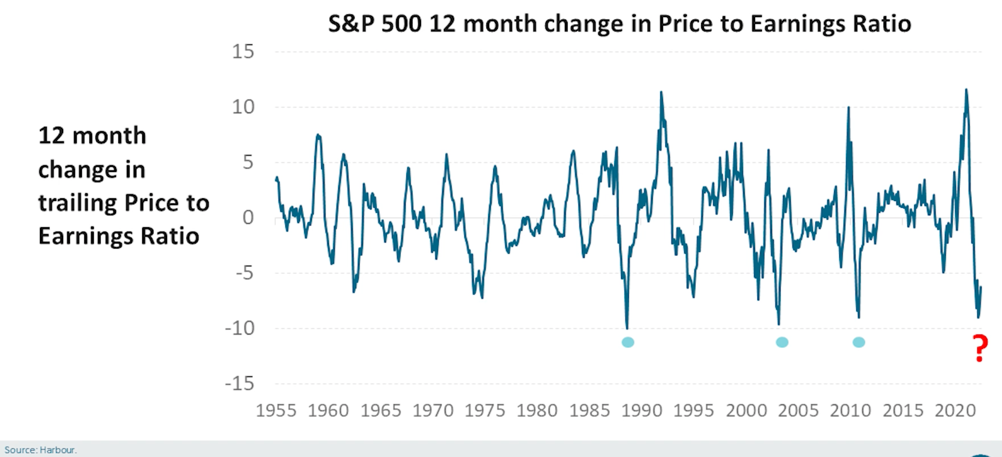
The above graph tracks the price to earnings ratio of the S&P 500 over 12-month periods.
Price to earnings ratios have contracted measurably over 2022. As if you didn’t know that right!? The above graph provides some perspective when compared to other notable multiple (price to earnings ratio) contractions. This one is meaningful.

The above graph tracks the share price movement for the global share market index to the right of the chart (MSCI, ACWI) and sectors within the index (to the left of the MSCI ACWI box).
The word ‘multiple’ is a bit of jargon just suggesting that price to earnings ratios (the multiple) have contracted meaning that trading prices compared to their underlying earnings have declined. In theory that means stocks are trading at cheaper levels.
The one caveat to all this is whether we see broad revisions of earnings right across the market. That would mean the “e” or the earnings component of the price to earnings multiple would be declining which would then stretch those P/E ratio multiples making prices more expensive again.
So far, we’ve seen some isolated and not insignificant earnings revisions. But generally earnings across the markets appear to be holding up reasonably well, at least so far. Let’s watch this space.
Companies trading below their two-year highs
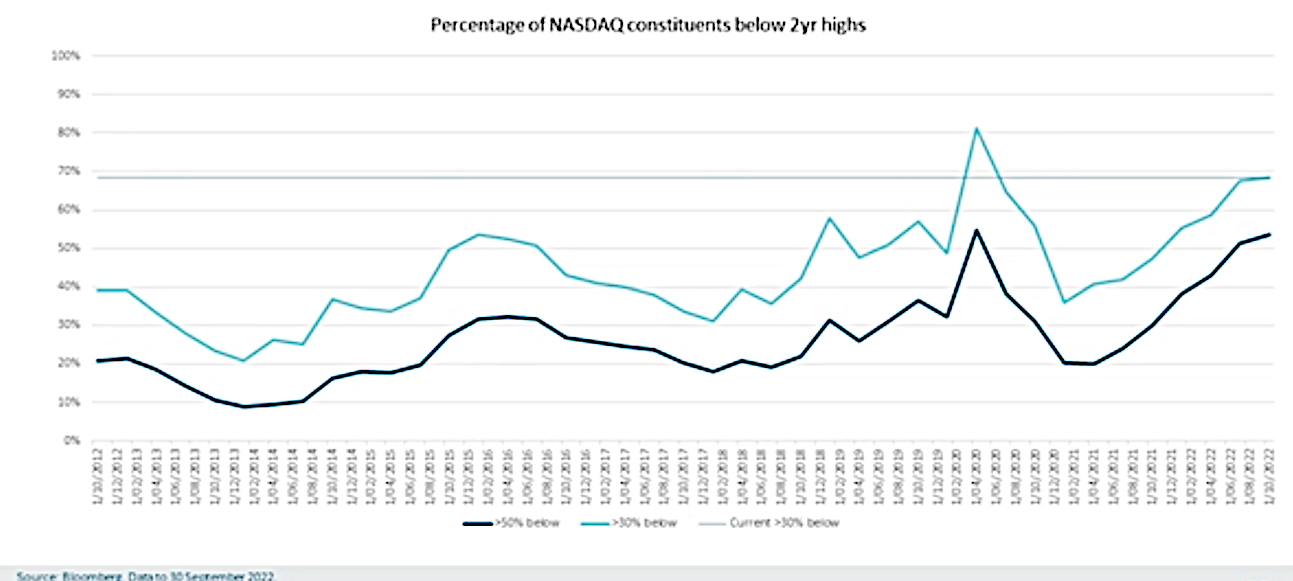
The above graph shows the percentage of stocks that are trading 30% and 50% below their two-year trading price high.
The graph above is based on stocks in the NASDAQ Index (the technology index). No surprises here that this index is bearing the brunt of multiple contractions. For example, some established companies such as Alphabet (Google) have missed on earnings which the market is unhappy about. That’s because the markets have seen the likes of Alphabet as a stalwart and to some degree a safe place to invest.
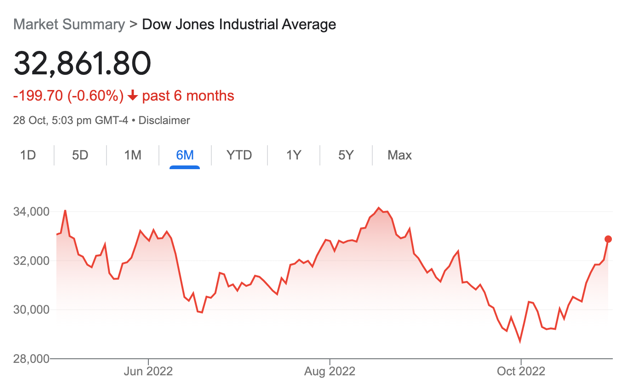
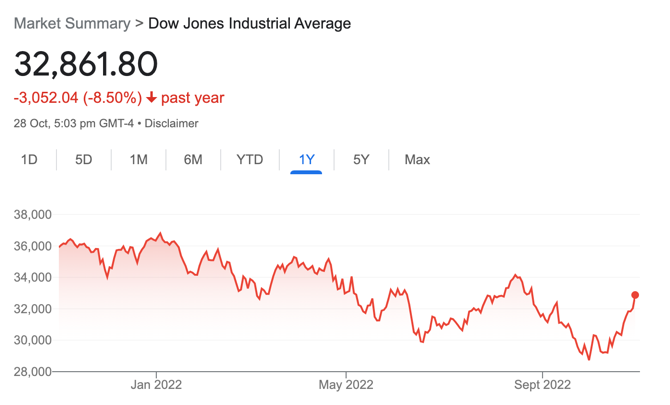
The chart on the left shows the US share market (the Dow Jones) over the last six months. The chart on the right shows the US share market (the Dow Jones) over the last year.
As you can see to the right of these graphs, volatility happens both on the downside and the upside.
At the time of preparing this report markets had just risen strongly. I regard this as short-term trading activity and market exuberance rather than any shift in the fundamentals of the markets (the market is just reacting positively to snippets of data suggesting inflation is showing signs of topping out).
US Federal Reserve and other central banks will get ahead of inflation
It’s just going to be a matter of the collateral damage involved in the process.
That would be rising levels of unemployment, slowing economic growth, potentially more broadly based earnings revisions on the downside and challenges for small businesses and Mums and Dads at the margin with tighter lending conditions.
That’s where we’re heading and so that’s why I’m thinking that we’ll see further volatility ahead which means that we’re heading in the right direction.
Steady as we go.
The Global Economy
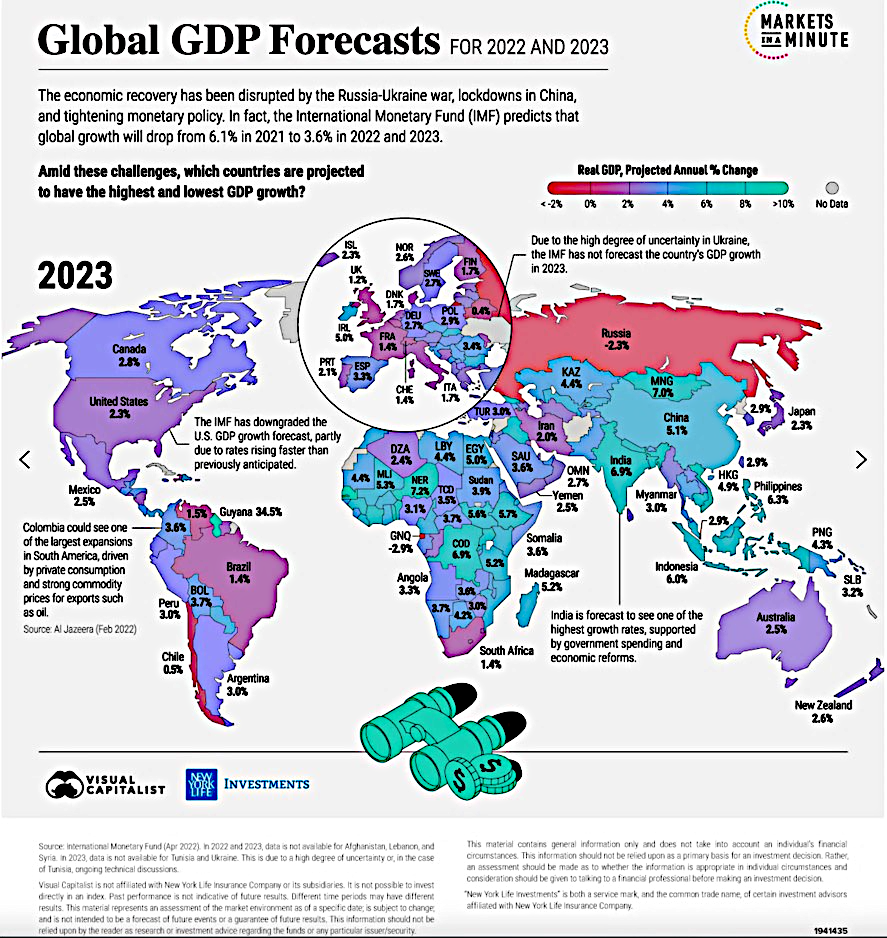
The above diagram outlines projected economic growth across the global economy for 2023.
The global economy is not exactly booming but on the other hand, is nowhere near global economic depression conditions. One thing we all know; unemployment in many countries around the world is tracking at somewhere around all-time lows. That is not depression conditions (but not helping lower inflation either!).
Inflation is not under control yet although, there are some faint signals that the so-called “US Fed pivot” whereby the Federal Reserve sees inflation data slowing, giving them the idea that they may slow down rate hikes and ultimately ease back interest rates at some point in the future.
However, in my view, whilst we are moving closer to that point, I don’t believe we’re there yet.
At the time of preparing this report (just prior to the upcoming US Federal Reserve interest rate announcement), it looks as though there will be another 75-basis point rate hike which many would argue is necessary in order to stay on track if the Fed is serious about getting ahead of the inflation curve.
Another point we’re thinking about is just how sticky inflation might be. Still, ‘the Fed pivot’ is on the horizon.
Where are we heading and what are the main scenarios?
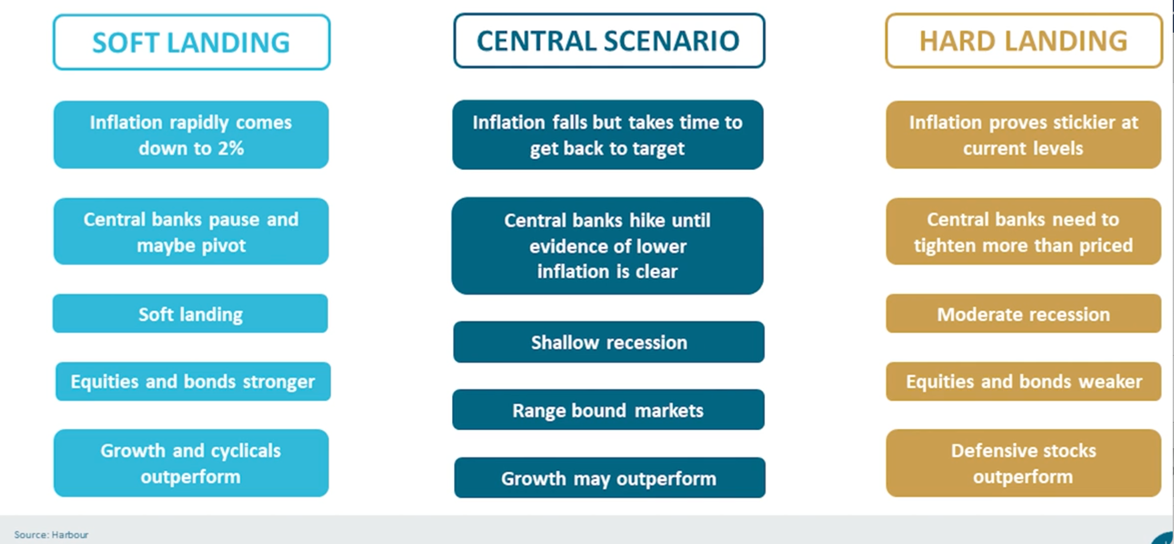
The above table outlines three scenarios, overviewing some detail around how each might look.
I’m thinking somewhere between the central scenario and the hard landing. That’s because it’s too early to know yet what’s involved in getting ahead of inflation and getting it under control.
Also, it’s too early to know what impact future rising unemployment, which hasn’t really started yet, will have on the economy and therefore what impact this might have on earnings for some companies. It’s just too early yet in my view.
The interesting question though is, how much of a hard landing has the market already priced into trading prices? What do you think?
As new data comes to hand, this can shift the playing field and make current assumptions look out of step. At the moment, my take is that markets may have priced in a large portion of my suggested scenario of a moderately hard landing.
We’ll get to see how far out of step that is as we move into 2023, which by the way is only weeks away – Christmas is coming!
The United States of America
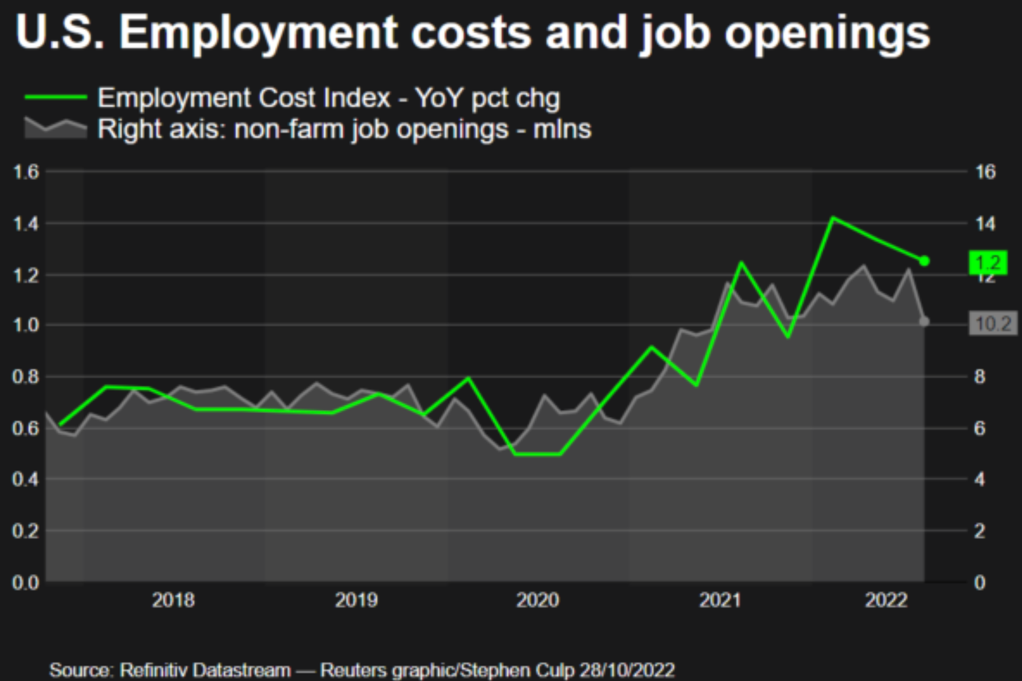
The above graph tracks US employment costs and job openings.
The markets got excited last week (the last week of October 2022), partly because of what the graph above is showing (those declining lines to the right of the graph). It doesn’t mean that inflation has been tamed though.
What it shows is that with the unemployment cost index is reducing (look to the right of the chart above). This reduces some price pressure which is good news for the US Federal Reserve – early days yet though. That’s because we don’t know how sticky wages costs will be moving forward.
Also, this is a small piece of recent data and is not a trend – not yet anyway.
However, with the private sector wage growth in the third quarter rising by 1.2% compared to 1.6% in the second quarter, this suggests that the likelihood of ever rising wages costs continuing to push higher may be reducing.
The other piece of data that US Fed is watching closely is the Personal Consumption Expenditures Index (Core PCE) which strips out the more volatile food and energy prices and as you may know, is US Federal Reserve’s preferred measure of inflation. This recently climbed by 5.1% year-over-year which was higher than the August rate of 4.9% but less than the consensus’ estimate of 5.2%.
Further, the housing market has been in decline in the US because of surging mortgage interest rates which will also be helping the Fed get in front of the inflation curve.
Consumer sentiment in America is not damaged yet but starting to feel somewhat subdued. I imagine consumer sentiment will continue to decline as interest rates bite, house prices continue to stagnate, and inflation costs squeeze incomes.
Although simplistic, this is all playing into the hands of the US Fed as they continue to battle inflation by raising interest rates.
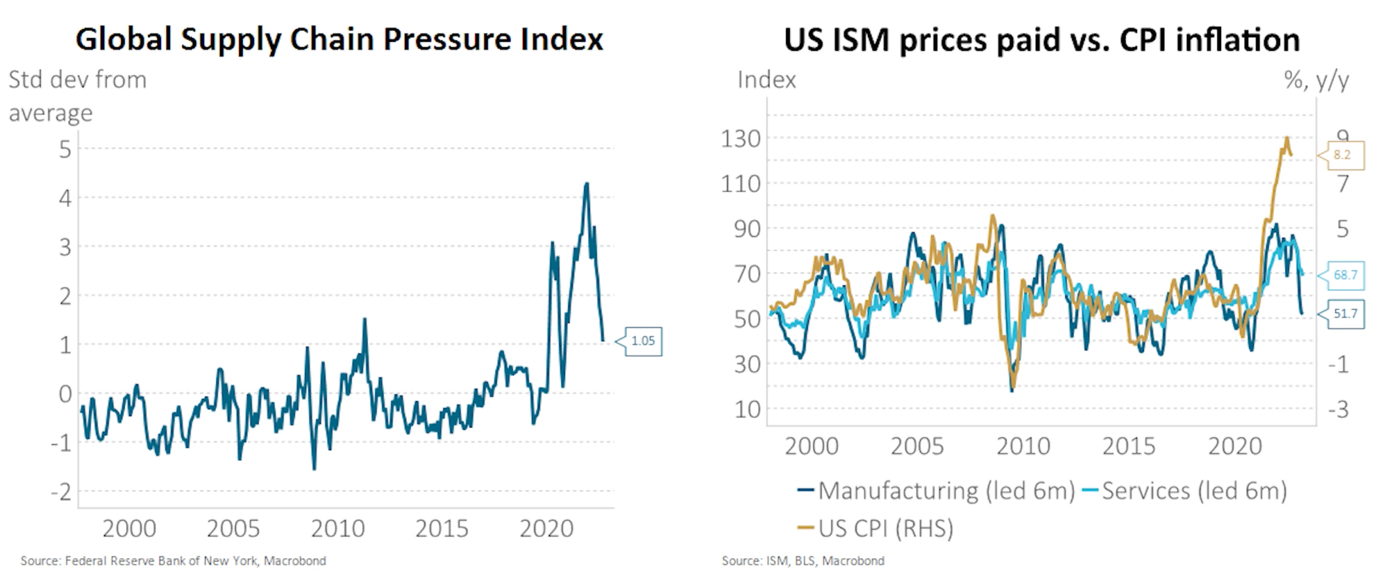
The graph to the left shows global supply chain movements. The graph to the right measures economic activity which is based on a survey of purchasing managers across America. This is considered a key indicator of the state of the US economy.
As the graph to the left above shows, global supply chain pressure has declined quite sharply recently. This doesn’t mean that there is no pressure, but the sharp spike has declined markedly.
The graph on the right also shows that activity in manufacturing and services has declined quite sharply which in the long-term would not be a good thing but short-term, is helping to reduce inflationary pressures.
This and other data suggest that, whilst as I said earlier, we’re not there yet, but nonetheless there are some signs that inflation pressures are being attacked with the help of rising interest rates and other adjustments across the economy, all helping to contain inflationary pressure.
China
Economic Growth – China
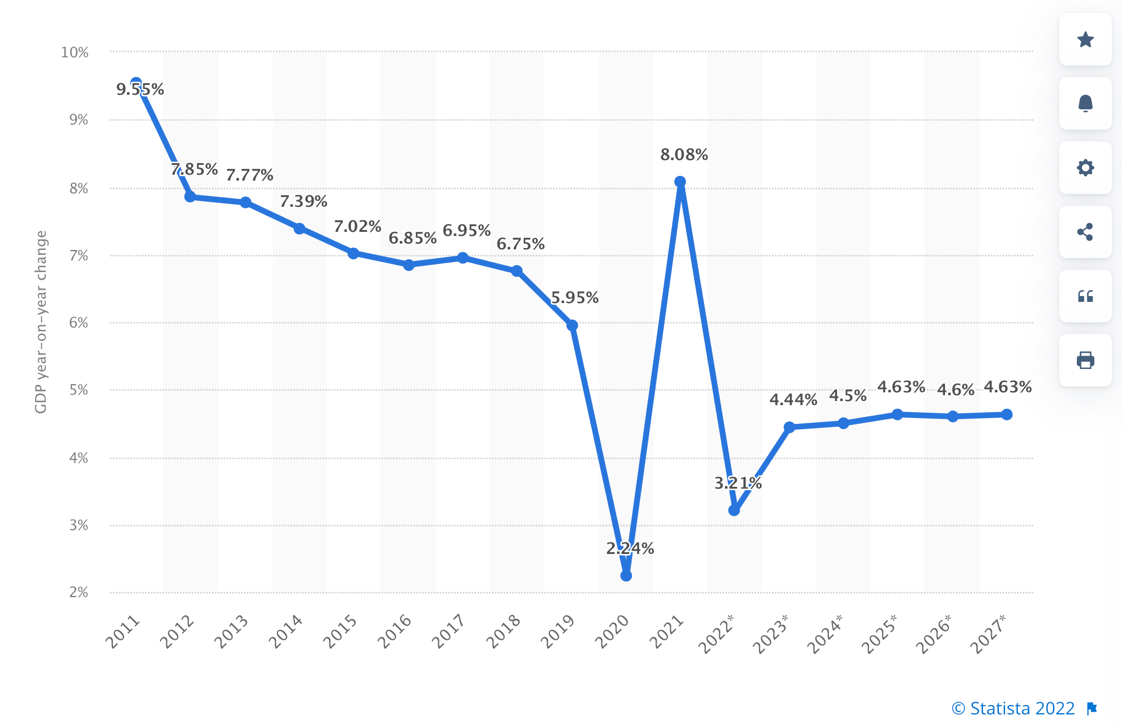
The above graph tracks economic growth across China and includes a projection to 2027.
Recent economic growth data out of China surprised on the upside with economic expansion as measured by GDP coming in at 3.9% year-on-year for the third quarter of 2022.
This is faster than the consensus forecast of 3.3% year-on-year.
Industrial production rose strongly at 6.3% between January and September. All of this despite the Covid lockdowns over much of 2022.
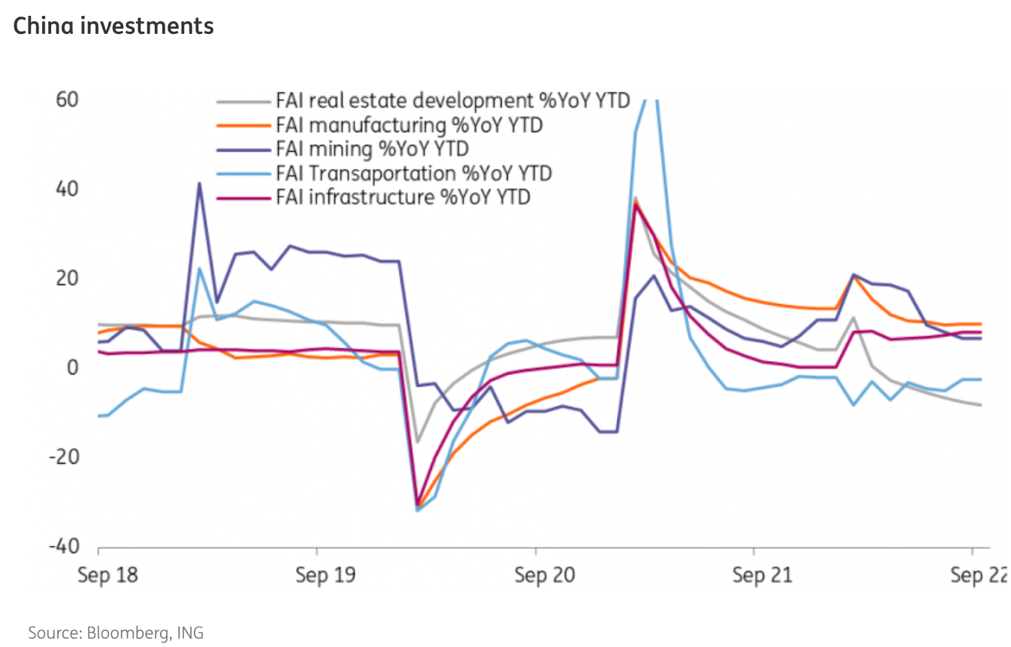
The above graph tracks investment activity across China.
You can see from the graph immediately above that manufacturing has continued to remain reasonably strong along with infrastructure spending in contrast however, with real estate which has been struggling.
A quick glance at the third quarter of 2022:
- Retail sales growth declined by 2.5%
- Over the first 9 months of the year, fixed asset investment increased by 5.9%
- Unemployment rose to 5.5% in September, from 5.3% in the previous month
- Export growth reduced from 7.1% in August to 5.7% in September, showing an overall decline in the third quarter
Chinese Premier Xi Jinping has solidified his grip on power, surrounding himself with loyal communist party members.
We’ll watch with interest as he delivers his plan for the people of China in the future and as we observe what that means for the rest of the world. Taiwan comes to mind however it’s a question of how he fulfils his goal of bringing Taiwan under the control of the Mainland.
Putting Xi Jinping / The Chinese Communist Party in a place where they need to ‘lose face’ could be a serious error by the US and other governments. Otherwise, firing missiles and putting boots on the ground looks unlikely.
Meanwhile, whilst the Chinese political party and Xi Jinping are intent on reducing their alliance on Western Trade, and in particular America. Nonetheless they do trade with western economies strongly at this stage and therefore they remain important to the global economy moving forward. At least for now.
Britain

Britain’s new Prime Minister Rishi Sunak delivers a speech outside Number 10 Downing Street in London on October 25th, 2022.
Lizz Truss is out – Rishi Sunak is in. It was bizarre however throughout it all, whilst the Pound did drop significantly, it has since recovered mostly, and the British economy continues.
Like many other economies, they face serious inflationary headwinds.
The difference now is that we may see more sensible austere measures that may provide a more permanent solution.
The idea of borrowing money to provide tax cuts to stimulate the economy was as bizarre as the political fiasco that unfolded over the last two months or so.
Australia

The above graph shows Australian interest rates (the red line) compared to the 90-day bill yield and real cash rate.
Inflation in Australia is a force to be reckoned with for the Australian Reserve Bank. However, the Australian Reserve Bank appears to be taking a more measured approach compared to other central banks.
They seem to be adopting a slower approach to increasing interest rates with a view that it may stretch out further into the future but might cause less pain along the way.
I imagine they will be watching carefully to ensure that inflation doesn’t become embedded, making it more difficult to achieve their goal.
New Zealand

New Zealand is on track and progressing reasonably well all things considered. Especially when you take into account that we are a very small player in a large global economy.
Debt has increased in New Zealand although to a manageable level and certainly less than a number of other developed economies around the world. Still, that doesn’t make it right.
Nonetheless that increased level of debt has helped New Zealand navigate its way through the Coronavirus to where we are now.
Moving forward, a more austere approach generally with some sound financial planning anytime soon does seem appropriate (!).
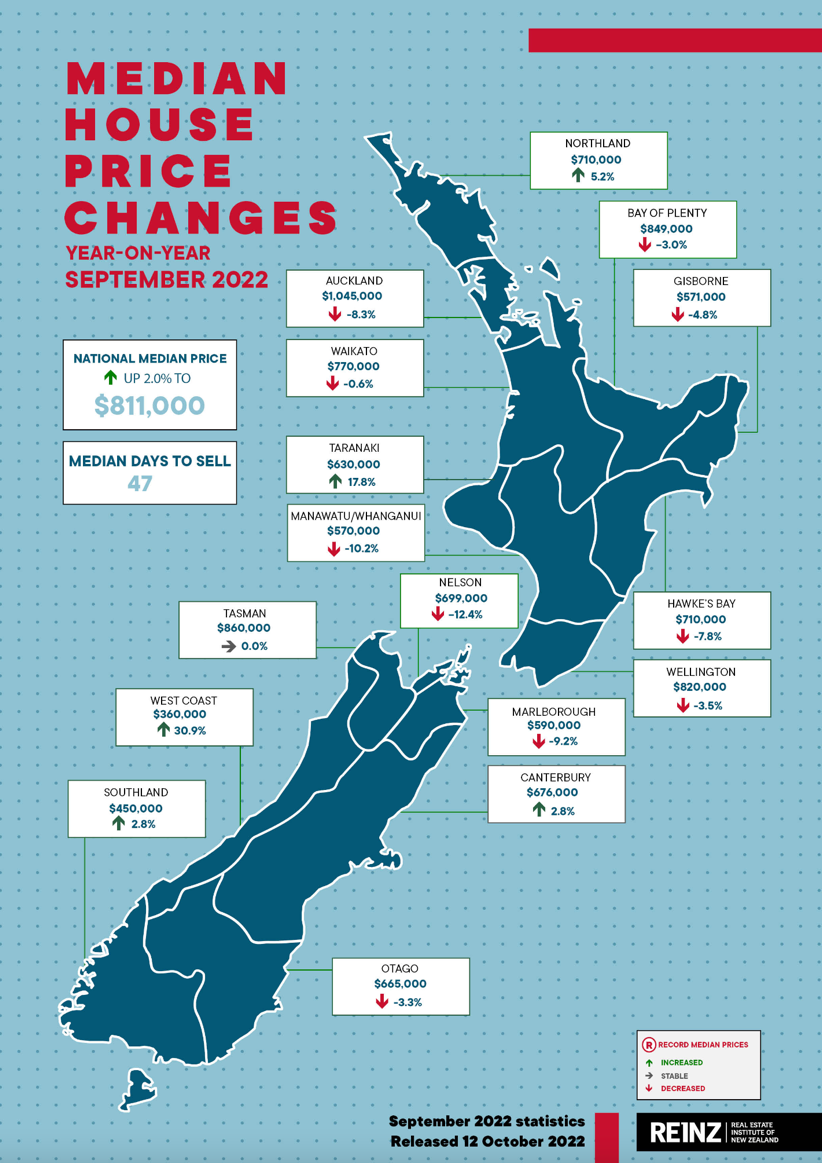
Interest rates in New Zealand are rising and property prices in certain areas are declining which makes sense. That’s the way it goes.
It will be interesting to see if predictions by ANZ Bank of a 20% + decline in property prices actually unfolds. Possibly in real terms.
Not surprising anyway given how expensive residential property prices have been and remain by a number of measures.
Still, the market determines the price. The fundamentals don’t always matter in the short-term when a willing buyer and a willing seller meet. Ultimately though, the fundamentals weigh on the price of any asset.
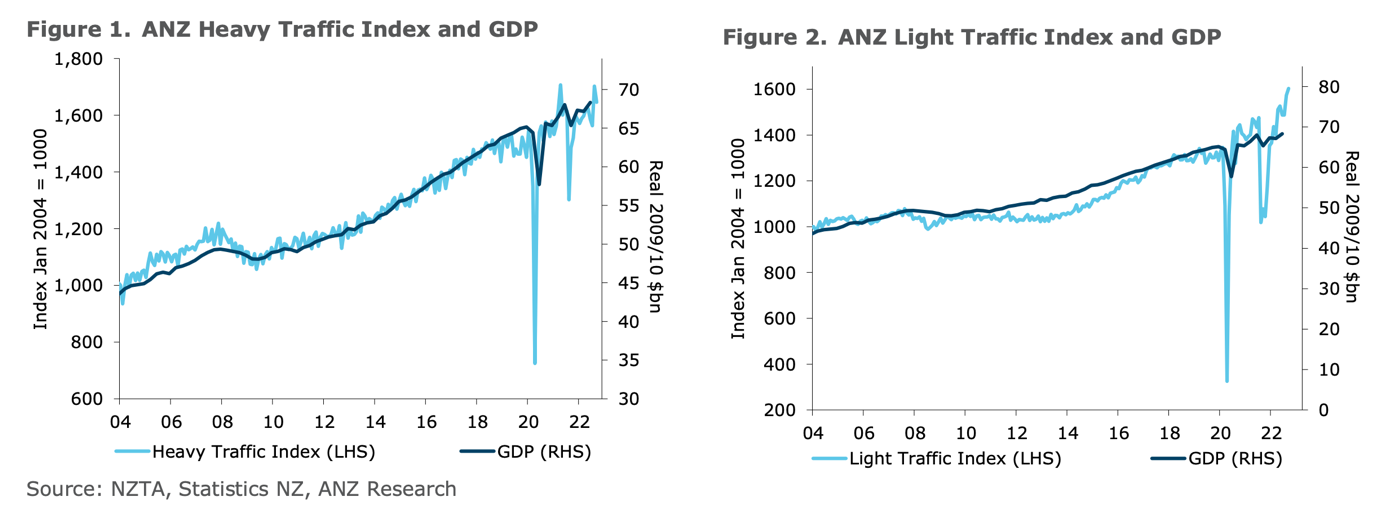
The graph to the left tracks the ANZ heavy duty truck-o-meter index. The chart to the right tracks the ANZ light traffic index.
The light traffic index increased 1.9% in September. The heavy traffic index eased by 3.3%, after strongly rising the previous month.
Truck movements in recent times probably reflect labour shortages as well as the impact of Covid.
Interestingly, the light traffic index can be a good indicator of consumer’s willingness to spend and has been reasonably strong of late.
Not ideal from Adrian Orr’s perspective. He’s the governor of the Reserve Bank of New Zealand and he’d be happy to see things slow down a bit. Indeed, consumer demand has remained reasonably resilient.
The heavy traffic index provides an indication of production and economic growth as per GDP. The index which increased by 1.6% quarter-on-quarter in the third quarter of this year suggests the economy in New Zealand continues to expand at a reasonably solid pace.
This is generally favourable however not so much when we think about the New Zealand Reserve Bank’s battle with inflation. It translates into ongoing interest rate increases and pain down the track for consumers.
To Summarise
Interest rates rise globally however generally economic growth remains resilient even if the global economy is not booming.
Interest rate increases will continue. I’m trying to think of a time when inflation has beaten the central bank’s attempt to curtail it. I’m not coming up with much.

The above graph tracks projected interest rates across New Zealand, America and Australia, highlighting the neutral range for comparison.
Central banks will likely win. As I mentioned earlier, it’s simply a question of the amount of collateral damage along the way.
I see very little in the data that suggests global economic depression.
We can see economic recession, with some countries moving in and out of recession in the future.
Whilst two consecutive quarters of economic contraction is a simple measure, recession can also involve the length of economic contraction, how widely spread the contractions are across the economy and how deep.
I’m thinking a modestly hard landing as distinct from a soft landing or a hard landing. What do you think?
Regardless, investing in quality businesses remains important. Prices are starting to become favourable. Targeted “nibbling” as volatility continues, and the market tries to work out how things are going economically looks like a smart idea moving forward.
The recent share market rally in America (the last week of October) does provide some indication of how quickly the market can pivot.
TIP: Investing opportunities tend to move away from where people think they are to where people think they can’t be … remember, people (the market) decide the trading price of stocks.

